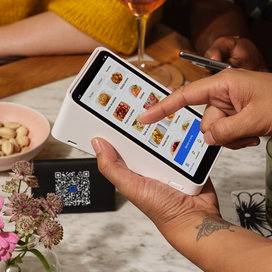Table of contents
Not so happy with the tips you’re getting? It might not be a reflection of your service — it might just be the state you live in.
Recently we looked at tips gathered from more than two million Square sellers across the country — everything from small businesses to large chains — to find the highest- and lowest-tipping states. We then compared those average tips to the median household income in each state, as measured by the 2015 U.S. Census.
And the results might make you say, “huh?”
Some of the states with the highest median household incomes (according to the 2015 U.S. Census) had the lowest gratuities. Hawaii, for instance, had an average gratuity of 14.8 percent, the lowest in the country, but it has one of the highest median household incomes at more than $75,000. Other places with high earners and low tippers included Washington, D.C. (14.9 percent), Massachusetts (15 percent), and California (15.2 percent), all of which have median incomes of more than $67,000.
On the flip side, some states whose residents’ household incomes are on the lower end turn out to have some of the most generous tippers. For example, Mississippi, Kentucky, Arkansas, and West Virginia all had average gratuities of at least 17 percent (and all have a median household income of less than $47,000).
You might not be able to change the tipping habits of your entire state, but there are steps you can take to improve the tips at your business. Here are some ideas to boost your gratuities.
Offer chip card and mobile payment options.
Last year, during an event in Portland, business owners found that tips increased when they started accepting mobile wallet and EMV chip card payments. Here’s the breakdown: 67 percent of customers who swiped their cards added a gratuity, compared with 71 percent who dipped their chip card and 73 percent who paid via mobile wallet.
So if you’re not accepting these new — and very secure — forms of payment yet, it’s time to upgrade your technology. Square Reader for contactless and chip lets you take all types of payment.
Include a “no tip” button in the checkout process.
Surprising as it might sound, a survey by Software Advice found that when customers had to either tip or hit a “no tip” button — like on Square’s point-of-sale system — they were more likely to add a gratuity.
It’s one thing to bypass a tip jar at the checkout counter or just leave the gratuity line blank when you’re signing a check, but it’s harder to physically press a button saying you aren’t going to leave anything.
(Square’s POS also has a function that allows you to add suggested tip amounts to the checkout screen. If you decide to customize these amounts, make sure the percentages or dollar amounts aren’t too high. This can alienate customers and make it less likely that they’ll come back.)
Position your register strategically.
In real estate and tipping, location matters. The same survey by Software Advice found that 41 percent of respondents said being near a cashier or server while entering a tip would “probably” or “definitely” increase their likelihood to tip. Try placing the register near a hub of server activity, or have servers bring an iPad to customers when they are paying their check.
Expedite the ordering process.
When people have to wait in a long line, they’re going to get frustrated. Frustrated customers probably aren’t going to feel very generous when it comes time to tip (especially if they’ve been waiting on their first coffee of the day).
At busy times, streamline the process by taking orders in line and having customers pay while they’re waiting. That way, customers know that you’re doing everything you can to get them in and out quickly, which they’ll keep in mind when it’s time to tip.
![]()











